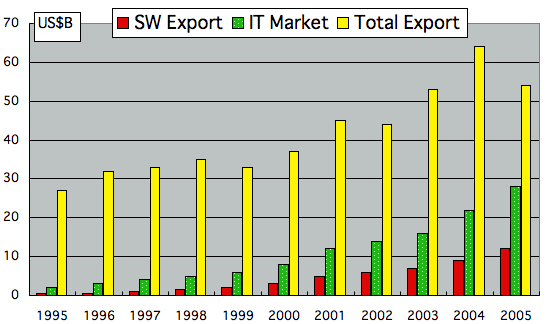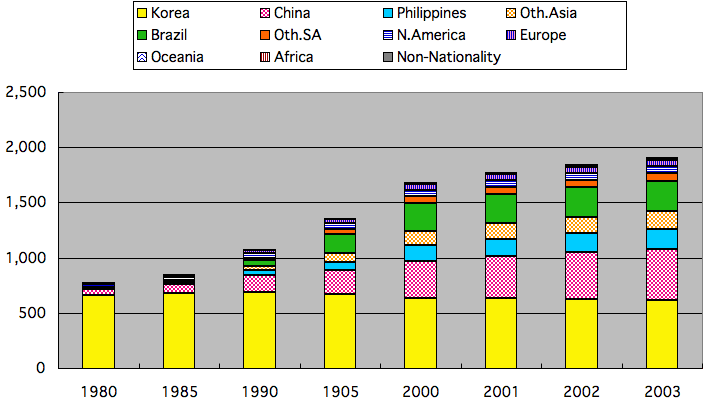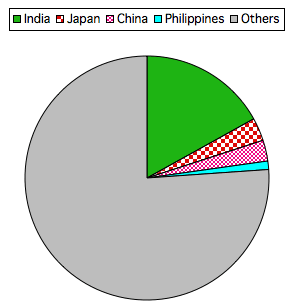 |
India's IT industry and its relations to Japan |
Cat: ICT |
Anthony P. D'Costa |
06323u/18215r |
Title
India's IT industry and its relations to Japan
インドIT産業と日本との関係
Author
Anthony P. D'Costa
アントニー・デコスタ
Index
- Prologue:
- Growth of Indian IT Industry:
- Favorable Factors of India:
- New Directions:
- India's position in the global IT industry:
- India-Japan Relationship:
- Basic argument:
- The formation of a global talent:
- Inflows of foreigners to Japan:
- Registered foreigners in Japan:
- Students from abroad in Japan:.
- Japanese Dilemma, USD Edge:
- US inflows of high-skilled workers:
- Distribution of H1B visa:
Why?
- We know little about India, but we know the activities of Indians
in IT industry.
- Prof. P. D'Costa shows how Indian engineers deeply involved and
are contributing IT industry in US.
- I remember that it was Indian high-tech venture companies such
as policy router and wireless simulation software, for which my
former company (NTI) functions as an agent in Japanese market.
- Further global collaboration with IC (India & China) would
be a key factor for competitiveness of Japanese IT industry.
- 我々はインドについてよく知らないがIT産業でのインドの活躍は知っている。
- D'Costa教授はインド技術者が米国IT産業において如何に深く関与し貢献しているか示してくれた。
- 前職(NTI)で日本市場向け代理店をしていた米国西海岸のPolicy routerの会社も無線シミュレーションソフトの会社もインド系のベンチャーであった。
- IC (インドと中国)との更なるグローバル協業は日本のIT産業の競争力の鍵となろう。
Summary
要約
>Top
0. Prologue:
- Professor Anthony P. D'Costa is professor, Comparative International
Development, Seattle, University of Washington, who made a presentation
of the latest India's IT Industry and its relations to Japan at
Waseda Univ. on Mar. 14, 2006 to the study group of Glocom, Int'l
Univ. of Japan.
- We must know another big elephant hidden behind the present
visible big elephant named China right in front of us.
- Ancient India believed this universe is supported by three
gigantic elephants: it might be true that world IT industry will
be supported by four gigantic elephants of US, EU, and India and
China in 21C.
0.序:
- Anthony P. D'Costa氏は、シアトルの米国ワシントン大学比較国際論の教授であり、今般3月に早稲田大学で国際大学Glocomの研究グループに対しインドのIT産業と日本との関係について講演があった。
- 今我々の目の前にある中国という名の巨像の後にもう一頭の巨像がいることを認識しなければならない。
- 古代中国はこの宇宙は3匹の巨大な象によって支えられて入ると信じた。それは本当かも知れない。21世紀には4匹の巨大な象(US,
EU, インド,中国) によって支えられていくのだろうか?
>Top
1. Growth of Indian IT Industry:
- The
chart shows India's IT industry change.
- The ratio of software export in IT market is very high: almost 40%,
this shows strong competitiveness in software, while weakness in hardware.

1.
インドIT産業の成張:
- 1995~2005年のIT産業の推移を示す。
- ソフトウェアの比率が高い (約40%)
- ハードウェア関連は弱い
>Top 2. Favorable Factors of India:
- Technical education infrastructure (ISI): reasonably good
- Large talent pool: similar to China
- Government deregulation, liberalization: gradually deregulated
- Entrepreneurial:
- English-speaking: like Finish
- Global opportunities (US market, PC, Y2K)
- Limited alternative employment: IT industry is major
2. インドの強み:
- 技術教育インフラ
- 膨大な有能人材源
- 規制緩和
- 起業家意識
- 英語力
- グロバールな機会 (米国市場、PC, Y2K)
- ITはすでに主要産業
>Top 3. New Directions:
- Social network issue: Technical community
- Situated in the international migration context:
- Globalization, epistemic communities, and innovation (development):
- Mobility of technical talent:
- Face to face interaction in software services:
- Tacit knowledge through social interaction:
- Vulnerability of India's IT suggests diversification:
3. 新たな動き:
- 社会ネットワーク
- 国際的移民の動き
- グローバリゼーション、認知コミュニティ、イノベーション
- 有能な技術の流動性
- ソフトウェアサービスにおける面談交流
- 社会的相互作用を通じた暗黙の知識
- IT産業の脆弱性が多様性を生む
>Top 4. India's position
in the global IT industry:
IT service spending ($B)
India's export ($M)
India's market share (%)
Relative dependence ratio
share in India's export (%)
N. America
171.1
6,685
3.92
1.4
67.7
W. Europe
109.6
2,103
1.92
0.7
21.3
Japan
34.9
193
0.55
0.2
2
L. America
17.5
583
3.33
1.2
5.9
Asia Pacific
16
311
1.94
0.7
3.2
Total
349.1
9875
2.82
100.1
- Source: NASSCOM, www.nasscom.org
- Note: Relative dependence measures the region's share in Indian
exports vis-a-vis region's share in world IT services spending.
4.
インドのIT産業の地位:
- 縦軸:
北米、西欧、日本、ラテンアメリカ、アジア太平洋地域の比較
- 横軸:
- IT支出額 ($B)
- インドからの輸出額($M)
- インドの各地域における市場シェア(%)
- 相対依存比率:
各地域のシェア/インドからの輸出を分子に 各地域シェア/世界のITサービスを分母にした相対比率
- インドからの輸出に占める各地域のシェア(%)
- インドIT産業との相互依存関係は、
米国、次いでラテンアメリカで、
日本が特に低い
>Top 5. India-Japan Relationship:
- Demographic dilemma in Japan:
- Shortage of labor (Pop. growth: 0.7% in rich, 2.1% in poor)
- By 2015 Japan's growth rate: -0.2%!
- Labor force from 68.2M/2001 to 66M/2010
- Increasing dependency ratio
- Need high productivity/high wage jobs
- Can't increase workforce from agriculture, automation, women,
fertility rates
- Migrant workers already in japan in labor intensive sectors;
SME's, construction, entertainment
- Indian IT industry growth ($50B)
- Recognition of HRST (Human Resource in Science and Technology)
- Little discussion on innovation, under-researched Japan
5.
日印関係:
- 日本の人口問題:
- 労働力不足
- 2015までの日本の人口伸び率:-0.2%!
- 労働力供給:68.2M/2001 から66M/2010
- 農業、自動車、女性、出生率いずからも労働力増加期待できない
- 外国人労働者は中小企業、建設、娯楽産業で採用
- インドのIT産業の成長
- 科学技術人材に対する認識
- 日本の研究開発投資軽視
>Top 6. Basic argument:
- Globalization: Trade, FDI (Foreign Direct Investment), Technology
Transfer, and Movement of people
- The Indian IT industry as a good example
- But the asymmetry between India and japan is stark
- Japan has its own challenges: demographic and competitiveness
- India has is own development problems
- How the two countries can forge a mutually beneficial partnership?
6. 論点:
- グローバリゼーションのあり方:
人(Movement)、物(Trade)、金(FDI)、情報(Tech Transfer)
- インドIT産業発展の事例
- 日印間の非対称問題
- 日本の挑戦課題:人口、競争力
- インド自身の発展課題
- 日印はいかに相互パートナーシップを築くべきか?
>Top 7. The formation
of a global talent:
- Epistemic community
- Social networks (density of networks)
- Nodes of knowledge workers
- Professional links between host and sending countries
- Students, professionals, academics, researchers
7.グローバル・タレントの養成:
- 認識的コミュニティ
- 社会ネットワーク (ネットワークの密度)
- 知的労働者のノード
- 受入国、派遣国間のプロフェッショナル・リンク
- 学生、専門家、学界、研究者
>Top 8. Inflows of foreigners
to Japan: (2000)
- China: 75,300
- Philippines: 74,200
- Brazil: 45,500
- US: 24,300
- Korea: 24,000
- UK: 7,000
- Thailand: 6,600
- Taiwan/Canada/Germany: 4,400
- Peru: 3,900
- ROW: 72,300
- Total: 345,800
- Citizenship is difficult!:
Definition of 'Immigrant' in Japan is different, which does not
mean settling in Japan, just temporary stay.
8.日本への外国人流入:
(2000)
- 中国: 75,300
- フィリピン: 74,200
- ブラジル: 45,500
- 米国: 24,300
- 韓国: 24,000
- 英国: 7,000
- タイ: 6,600
- 台湾/カナダ/ドイツ: 各 4,400
- ペルー: 3,900
- その他: 72,300
- 合計: 345,800
- 市民権取得は困難:
日本では'Immigrant'の意味が異なる。移住を意味しない。短期滞在中心。
>Top 9. Registered foreigners
in Japan:

- Total number of registered foreigners in Japan increased during
1990s, but has saturated after 2000.
- Chinese nationality is increasing since 2000.
- In 2003 ranking of number of registered foreigners in Japan:
1) Korea 614K, 2) China 462K, 3) Brazil 275K, 4) Philippine 185K,
5) Peru 54K, 6) Thailand 35K, 7) Vietnam 24K, 8) Indonesia 23K,
9) India 14K, 10) Australia 12K
9.
日本滞在外国人数:
- <左図>
- 1990年代に日本滞在外国人数が増加したが、2000以降はその伸びは緩やか
- 中国国籍者数が2000年以降増加
- 2003年の国別滞在外国人数は
- 韓国:614K
- 中国:462K
- ブラジル:275K
- フィリピン:185K
- ペルー:54K
- タイ:35K
- ベトナム:24K
- インドネシア:23K
- インド:14K
- 豪州:12K
>Top  10. Students from
abroad in Japan: (Age 20-25; 2003)
10. Students from
abroad in Japan: (Age 20-25; 2003)
- Ranking: 1) China 54600; 2) Korea 11481; 3) Oth.Asia 6288; 4)
Taiwan 3388; 5) Europe 2680; 6) Malaysia 1677; 7) Indonesia 1438;
8) N-America 1510; 9) L-America 982; 10) Africa 859; 11) Middle
East 590; 12) Oceania 509
10.
滞在外国人留学生:
- <左図> 2003年、年齢20-25:ランキング
- 中国:54,600
- 韓国:11,481
- 他アジア:6,288
- 台湾:3,388
- 欧州:2,680
- マレーシア:1,677
- インドネシア:1,438
- 北米:1,510
- 中南米:982
- アフリカ:859
- 中東:590
- 大洋州:509
>Top 11. Japanese Dilemma,
USD Edge:
- In Japan:
- Immigration limits: 0.5% of total entrants are technical talent
- Students from China, Korea and other Asia.
- Few students remained: 2,624 changed residency status for
employment (1997)
- Few It workers: 400 Indian engineers
- Few Indian students to Asia/Japan
- In US:
- Indians in US represent 78% of Indians in OECD
- But comprise only 4% of foreigners in OECD total
- 10% of foreign students in US are Indians.
- 30,000 Indian doctorates in S/E in US (1999)
- 50% of Indian S/E students in US plan to remain
- India dependent on US
- H1B visas (49% Indians, 92% in IT industry)
11.インド人活用日米比較:
- <日本>:
- 日本の移民制限:
技術者は0.5%
- 学生は中国、韓国などアジア
- 学生は残らない
- IT従事者少ない
- <米国>:
- 在米インド人:OECD中では78%
- 但しOECDの外国人数の4%
- 米国の学生の10%はインド人
- インド人博士は3万人
- 技術系学生の50%は米国滞在予定
- インドは米国は依存
- H1Bビザは、49%インド人、92% IT産業
>Top 12. US inflows of
high-skilled workers:

- Source: US Department of Homeland Security, 2004
- Numbers is 1000
- After 9.11 the number is not increased.
12.エンジニアの米国への流入:
- 9.11以降は増加していない
>Top 13. Distribution
of H1B visa:

- Source: US dept. of Homeland Security 2004
- India' share is 21.1%, then Japan 3.7%, and China 3.5% in leading
Asian countries.
- It is surprising that the share of Japan is slightly bigger than
that of China. Because probability of success stories may be different
between China and Japan after their return home.
13.H1Bビザ発給者分布:
- <左図
- インドは21.1% ( 2003)
- ランキング:
- インド:21.1%
- 日本:3.7%
- 中国:3.5%
- 日本が中国より多いのは意外な気がする。
- 帰国後の活躍度の違いもあるかも知れない。
Comment
- This report shows how India's involvement to US, particularly
IT industry is big, while how scarcely Japan utilizing Indians'
talent and ability in Japanese IT industry.
- S/E engineers' ability resemble to those of athlete: how US immigrant
athletes gains medals in Olympic games.
- 本レポートはインドが米国の特にIT産業にどれほど関与しているか、他方日本は如何にインドの能力を日本のIT産業に活用していないかを示す。
- 科学技術エンジニアの能力はスポーツ選手のそれに似ている。米国はオリンピックで移民のスポーツ選手が活躍してメダルを獲得している。
Title |
India's IT industry and its relations to Japan |
インドIT産業と日本との関係 |
|---|---|---|
Author |
Anthony P. D'Costa | アントニー・デコスタ |
Index |
|
|
Why? |
|
|
Summary |
要約 |
|||||||||||||||||||||||||||||||||||||||||
>Top 0. Prologue:
|
0.序:
|
|||||||||||||||||||||||||||||||||||||||||
>Top 1. Growth of Indian IT Industry:
|
1. インドIT産業の成張:
|
|||||||||||||||||||||||||||||||||||||||||
>Top 2. Favorable Factors of India:
|
2. インドの強み:
|
|||||||||||||||||||||||||||||||||||||||||
>Top 3. New Directions:
|
3. 新たな動き:
|
|||||||||||||||||||||||||||||||||||||||||
>Top 4. India's position in the global IT industry:
|
4. インドのIT産業の地位:
|
|||||||||||||||||||||||||||||||||||||||||
>Top 5. India-Japan Relationship:
|
5. 日印関係:
|
|||||||||||||||||||||||||||||||||||||||||
>Top 6. Basic argument:
|
6. 論点:
|
|||||||||||||||||||||||||||||||||||||||||
>Top 7. The formation of a global talent:
|
7.グローバル・タレントの養成:
|
|||||||||||||||||||||||||||||||||||||||||
>Top 8. Inflows of foreigners to Japan: (2000)
|
8.日本への外国人流入: (2000)
|
|||||||||||||||||||||||||||||||||||||||||
>Top 9. Registered foreigners in Japan:
|
9. 日本滞在外国人数:
|
|||||||||||||||||||||||||||||||||||||||||
>Top
|
10. 滞在外国人留学生:
|
|||||||||||||||||||||||||||||||||||||||||
>Top 11. Japanese Dilemma, USD Edge:
|
11.インド人活用日米比較:
|
|||||||||||||||||||||||||||||||||||||||||
>Top 12. US inflows of high-skilled workers:
|
12.エンジニアの米国への流入:
|
|||||||||||||||||||||||||||||||||||||||||
>Top 13. Distribution of H1B visa:
|
13.H1Bビザ発給者分布:
|
Comment |
|
|